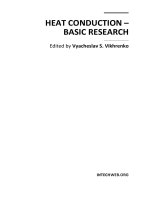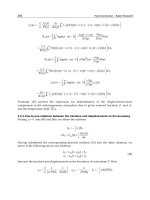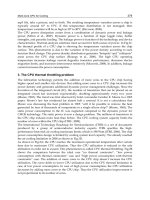Convection and Conduction Heat Transfer Part 14 pptx
Bạn đang xem bản rút gọn của tài liệu. Xem và tải ngay bản đầy đủ của tài liệu tại đây (1.71 MB, 16 trang )
Finite Element Methods to Optimize by Factorial
Design the Solidification of Cu-5wt%Zn Alloy in a Sand Mold
379
1.1 Mathematical solidification heat transfer model
The mathematical formulation of heat transfer to predict the temperature distribution
during solidification is based on the general equation of heat conduction in the unsteady
state, which is given in two-dimensional heat flux form for the analysis of the present study
(Ferreira et al., 2005; Santos et al., 2005; Shi & Guo, 2004; Dassau et al., 2006).
(
)
=
+
+
(1)
where ρ is density [kgm
-3
]; c is specific heat [J kg
-1
K
-1
]; k is thermal conductivity [Wm
-1
K
-1
];
∂T/∂t is cooling rate [K s
-1
], T is temperature [K], t is time [s], x and y are space
coordinates
[m] and
represents the term associated to the latent heat release due to the
phase change.
In this equation, it was assumed that the thermal conductivity, density, and specific heat
vary
with temperature. In the current system, no external heat source was applied and the
only heat generation was due to the latent heat of solidification, L (J/kg) or ΔH (J/kg).
is
proportional to the changing rate of the solidified fraction, f
s
, as follow (Ferreira et al, 2005;
Santos et al, 2005; Shi & Guo, 2004).
=∆
=
=
(2)
Therefore, Eq. (2) is actually dependent on two factors: temperature and solid fraction. The
solid fraction can be a function of a number of solidification variables. But in many systems,
especially when undercooling is small, the solid fraction may be assumed as being
dependent on temperature only. Different forms have been proposed to the relationship
between the solid fraction and the temperature. One of the simple forms is a linear
relationship (Shi & Guo, 2004; Pericleous et al., 2006):
=
0
(
)/(
)
1
(3)
where
and
are, respectively, the liquid and solid temperature (K). Another relation is
the widely used Scheil relationship, which assumes uniform solute concentration in the
liquid but no diffusion in the solid (Shi & Guo, 2004):
=1
(4)
where k
o
the equilibrium partition coefficient of the alloy.
Eq. (1) defines the heat flux (Radovic & Lalovic, 2005), which is released during liquid
cooling, solidification and solid cooling in classical models. The heat evolved after
solidification was assumed to be equal zero, i.e. for
,
=0. However, experimental
investigations have showed that lattice defects and vacancy are condensed in the already
solidified part of the crystal and the enthalpy of the solid increases and thus the latent heat
will decrease (Radovic & Lalovic, 2005). Due to this fact, another way to represent the
change of the solid fraction during solidification can be written as (Radovic & Lalovic, 2005):
(
)
+
(
)
(1
(
)
(
)
(
)
(1 2/)
(5)
Convection and Conduction Heat Transfer
380
Considering c´, as pseudo specific heat, as
=
and combining Eqs. (1) and (2), one
obtains (Shi & Guo, 2004 ; Radovic & Lalovic, 2005):
(
)
=()
(6)
The boundary condition applied on the outside of the mold is:
=(
)
(7)
Here h is the heat transfer coefficient for air convection and T
o
is the external temperature.
1.2 The factorial design technique
The factorial design technique is a collection of statistical and mathematical methods that
are useful for modeling and analyzing engineering problems. In this technique, the main
objective is to optimize the response surface that is influenced by various process
parameters. Response surface methodology also quantifies the relationship between the
controllable input parameters and the obtained response surfaces (Kwak, 2005). The design
procedure of response surface methodology is as follows (Gunaraj & Murugan, 1999):
i. Designing of a series of experiments for adequate and reliable measurement of the
response of interest.
ii. Developing a mathematical model of the second-order response surface with the best
fittings.
iii. Finding the optimal set of experimental parameters that produce a maximum or
minimum value of response.
iv. Representing the direct and interactive effects of process parameters through two and
three-dimensional plots. If all variables are assumed to be measurable, the response
surface can be expressed as follows (Aslan, 2007; Yetilmezsoy et al., 2009; Pierlot et al.,
2008; Dyshlovenko et al. 2006):
y= f(
x
1
,
x
2
,
x
3
,
…
x
k
)
(8)
where y is the answer of the system, and x
i
the variables of action called variables (or
factors).
The goal is to optimize the response variable y. It is assumed that the independent variables
are continuous and controllable by experiments with negligible errors. It is required to find
a suitable approximation for the true functional relationship between independent variables
(or factors) and the response surface. Usually a second-order model is utilized in response
surface methodology:
=
+
+
+
+
(9)
where x
1
, x
2
,…,x
k
are the input factors which influence the response y; β
o
, β
ii
(i=1, 2,…,m), β
ij
(i=1, 2,…,m; j=1,2,…,m) are unknown parameters and ε is a random error. The β coefficients,
which should be determined in the second-order model, are obtained by the least square
method.
Finite Element Methods to Optimize by Factorial
Design the Solidification of Cu-5wt%Zn Alloy in a Sand Mold
381
The model based on Eq. (9), if m=3 (three variables) this equation is of the following form:
=
+
+
+
+
+
+
+
+
+
+
(10)
where y is the predicted response, β
o
model constant; x
1
, x
2
and x
3
independent variables; β
1
,
β
2
and β
3
are linear coefficients; β
12
, β
13
and β
23
are cross product coefficients and β
11
, β
22
and
β
33
are the quadratic coefficients (Kwak, 2005).
In general Eq. (9) can be written in matrix form (Aslan, 2007).
Y
=
b
X
+
ε
(11)
where Y is defined to be a matrix of measured values, X to be a matrix of independent
variables. The matrixes b and ε consist of coefficients and errors, respectively. The solution
of Eq. (11) can be obtained by the matrix approach (Kwak, 2005; Gunaraj & Murugan, 1999).
b
=
(X‘X
)
-
1
X‘
Y
(12)
where X’ is the transpose of the matrix X and (X’X)
-1
is the inverse of the matrix X’X.
The objective of this work was to study the solidification process of the alloy Cu-5 wt %Zn
during 1.5 h of cooling. It was optimized through the factorial design in three levels, where
the considered parameters were: temperature of the mold, the convection in the external
mold and the generation of heat during the phase change. The temperature of the mold was
initially fixed in 298, 343 and 423 K, as well as the loss of heat by convection on the external
mold was fixed in 5, 70 and 150 W/m
2
.K. For the generation of heat, three models of the
solid fraction were considered: the linear relationship, Scheil´s equation and the equation
proposed by Radovic and Lalovic (Radovic & Lalovic, 2005). As result, the transfer of heat,
thermal gradient, flow of heat in the system and the cooling curves in different points of the
system were simulated. Also, a mathematical model of optimization was proposed and
finally an analysis by the factorial design of the considered parameters was made.
2. Methodology of the numerical simulation
The finite elements method was used in this study (Su, 2001; Shi & Guo, 2004; Janik & Dyja,
2004; Grozdanic, 2002). Software program Ansys version 11 (Handbook Ansys, 2010) was
used to simulate the solidification of alloy Cu-5 wt %Zn in green-sand mold. Effects due to
fluid motion and contraction are not considered in the present work. The geometry of the
cast metal and the greensand mold is illustrated in Figure 1(a), which is represented in
three-dimensions. However, in this work the analysis was accomplish in 2-D, which is
illustrated in Figure 1(b). Some material properties of Cu-5 wt %Zn alloy were taken from
the reference Miettinen (Miettinen, 2001), the other properties were taken from Thermo-calc
software (Thermo-calc software, 2010), and in Figure 2 the enthalpy and the phase diagram
of alloy Cu-Zn are presented (Thermo-calc software, 2010). Three pseudo specific heat (c´)
obtained from the equations (3), (4) and (5) were used and these equations were denoted
respectively by models A, B and C, and the sand thermo-physical properties was given by
Midea and Shah (Midea and Shah, 2002).
In this study, the Box–Behnken factorial design in three levels (Aslan, 2007; Paterakis et al.,
2002; Montgomery, 1999) was chosen to find out the relationship between the response
38
Fi
g
Fi
g
5
w
fu
n
th
e
of
so
l
w
a
in
t
2
g
. 1. The cast par
t
g
. 2. (a) Enthalp
y
w
t%Zn allo
y
(The
r
n
ctions. Indepen
e
mold temperat
u
the latent heat
l
idification. The
f
a
s adopted, whe
r
t
ermediate state
b
(a)
t
and mold in (a)
and phase dia
g
r
a
r
mo-calc softwar
dents variables
(
u
re (x
1
), the conv
e
release, (Z) re
p
f
actorial desi
g
n i
s
r
e for the inferi
o
by
(0) and for the
three dimension
a
a
m of Cu-5 wt %
Z
e, 2010)
(
factors) and the
i
e
ction phenome
n
p
resents the res
u
s
shown in Tabl
e
o
r state of the
v
superior state b
y
Convection an
d
(b)
a
l and (b) bi dim
e
Z
n allo
y
and (b)
p
i
r coded/actual
l
n
on (x
2
) and the
m
u
lt of the temp
e
1. For this desi
g
v
ariable it was d
e
y
(+1).
d
Conduction Heat
T
e
nsional
p
hase dia
g
ram o
f
l
evels considere
d
m
athematical mo
d
erature after 1.
5
g
n t
y
pe a nomen
c
enoted b
y
(-1),
f
T
ransfe
r
f
Cu-
d
were
d
el (x
3
)
5
h of
c
lature
f
or the
Finite Element Methods to Optimize by Factorial
Design the Solidification of Cu-5wt%Zn Alloy in a Sand Mold
383
x
1
Mold
Temperature
x
2
Convection
phenomenon (h
f
)
x
3
Mathematic
model
Z - Temperature after
1.5 h of solidification
(K)
-1 298 K 5 W/m
2
K A
0 343 K 70 W/m
2
K B
+1 423 K 150 W/m
2
K C
1 -1 -1 -1 806.799
2 -1 -1 0 775.945
3 -1 -1 +1 862.902
4 -1 0 -1 800.301
5 -1 0 0 769.408
6 -1 0 +1 855.752
7 -1 +1 -1
798.197
8 -1 +1 0
767.562
9 -1 +1 +1
854.967
10 0 -1 -1 840.174
11 0 -1 0 809.199
12 0 -1 +1 897.176
13 0 0 -1 833.699
14 0 0 0 802.835
15 0 0 +1 890.279
16 0 +1 -1 832.200
17 0 +1 0 801.430
18 0 +1 +1 890.110
19 +1 -1 -1 899.860
20 +1 -1 0 868.171
21 +1 -1 +1 958.587
22 +1 0 -1 893.996
23 +1 0 0 862.277
24 +1 0 +1 953.026
25 +1 +1 -1 893.136
26 +1 +1 0 861.015
27 +1 +1 +1 952.674
Table 1. Factorial design of the solidification process parameters
Convection and Conduction Heat Transfer
384
The initial and boundary conditions were applied to geometry of Figure 1 according to
Table 1. The boundary condition was the convection phenomenon and this phenomenon
was applied to the outside walls of the sand mold, as shown in Table 1. The convection
transfer coefficient at the mold wall was considered constant in this work, due to lack of
experimental data. The effects of the refractory paint and of the gassaging process were not
taken into consideration either. The final step consisted in solving the problem of heat
transfer of the mold/cast metal system using equation (6), in applied
boundary condition
and in controlling the convergence condition. Heat transfer is analyzed in 2-D form, as well
as the heat flux, the thermal gradient, and in addition, the thermal history for some points in
the cast metal and in the mold is discussed.
3. Result and discussion
The result for solidification was discussed for some particular cases, at condition given in
lines 7, 8 and 9 from Table 1, which correspond respectively to the lowest temperatures for
each mathematical model of latent heat release. Each one of the lines corresponds to the
temperature of the mold for the lower state (-) and for convection phenomenon for the
higher state (+).
(a) (b)
Fig. 3. Temperature distribution in (a) sand mold system, (b) cast metal (line 9 of Table 1)
The condition mentioned on line 9 of Table 1 was chosen to present heat transfer results,
where the temperature field is shown in Figure 3(a) in all the system mold and in the cast
metal (Figure 3(b)). This last case can be visualized in more detail in part (b), where an
almost uniform temperature is observed. In the geometric structure of the mold there is a
core constituted of sand that is represented by a white circle in Figure 3(b), which can be
verified also in Figure 1(a). In Figure 4 the results of the thermal gradient and the thermal
flux are shown, where the thermal gradient goes from the cold zone to the hot zone. On the
other hand, the thermal flux goes from the hot zone to the cold zone. Also the convergence
of the solution was studied; this point is discussed in more detail by Houzeaux and Codina
(Houzeaux & Codina, 2004).
Finite Element Methods to Optimize by Factorial
Design the Solidification of Cu-5wt%Zn Alloy in a Sand Mold
385
(a) (b)
Fig. 4. (a) Thermal gradient (K/m) in vector form and (b) Heat flux (W/m
2
) in vector form
(line 9 of Table 1)
In order to simulate the cooling curves, two points were considered, as shown in Figure 5:
one located in the core (point 2) and the other in the metal (point 1). The three forms of
latent heat release were applied into the mathematical model and the resulting thermal
profiles were compared.
Fig. 5. Reference points for the mold/metal system
The cooling curves were studied for condition of line 7, 8 and 9 from Table 1 as shown in
Figure 6. Figure 6 (a) shows a comparison of temperature evolution at point (2) for the three
formulations of latent heat release: linear (model A), Scheil (model (B) and Radovic and
Lalovic (model C). It can be observed that the highest temperature profile corresponds to
model A, followed by model C and last by model B, mainly after the solidification range.
Although not presented, a similar behavior has occurred at other positions in the casting.
Chen and Tsai (Chen and Tsai, 1990) analyzed theoretically four different modes of latent
heat release for two of alloys solidified in sand molds: Al-4,5wt%Cu (wide mushy region,
136K ) and a 1wt% Cr steel alloy (narrow mushy region, 33.3K). In their work, they conclude
that no significant differences can be observed in the casting temperature for different
modes of latent heat release, when the alloy mushy zone is narrow.
The alloy used in the present work, Cu-5wt%Zn, as shown in Figure 2(b), has a narrow
mushy zone (less than 10K). Figure 6(a) shows that there is a significant temperature profile
difference due to the three different latent heat release modes. In addition, it is important to
remark that the latent heat release form has strongly influenced the local solidification time.
2
1
38
S
u
se
c
so
l
co
r
ar
m
et
Fi
g
fo
r
pr
o
is
r
T
h
li
n
w
h
fa
c
Fi
g
1.
(
A
Y
e
an
Fi
g
le
v
ad
th
e
pa
re
l
In
an
in
d
an
6
u
ch solidificatio
n
c
ondar
y
dendriti
l
idification (t
SL
)
r
relatin
g
ultimat
e
m
spacin
g
s have
al., 2000).
g
ure 6 (b) sho
w
r
mulations of lat
o
file correspond
s
r
epeated for the
o
h
e si
g
nificant var
n
ear re
g
ression a
h
ich is a respo
n
c
torial desi
g
n.
g
. 6. Thermal pro
f
(
a) Inside of the
c
three level Box
-
e
tilmezso
y
et al.,
d x
3,
based in T
a
g
ure 7. In this fi
g
v
el (p) of 95%, sh
o
opted for this a
n
e
main effect of
rameter 2 (conv
e
l
ease form).
Fi
g
ure 7, two si
g
d x
3
(mathemat
i
d
ependent varia
b
al
y
sis, other t
y
p
e
(a)
n
parameter affe
c arm spacin
g
s.
are well know
n
e
tensile stren
g
th
shown that (
)
w
s a compariso
n
ent heat release.
s
to model A, foll
o
o
ther points in th
iables indicated
nd anal
y
sis of
v
n
se surface met
h
f
iles for the mol
d
c
ast – point 1, (b)
I
-
Behnken desi
g
(
2009) was used
a
ble 1. The resu
l
g
ure the estimate
d
o
win
g
the varia
b
n
al
y
sis was, “L”
m
the first factor
e
ction phenome
n
g
nificant influen
c
i
cal model) wit
h
b
les and interac
t
e
of standard
g
r
a
cts the microst
r
Correlations bet
w
n
in the literat
u
(
) and second
a
increases with d
e
n
of temperatur
e
It can be obser
v
o
wed b
y
model
C
e mold.
b
y
the Pareto c
h
v
ariance) were o
p
h
odolo
gy
, based
d
/metal s
y
stem c
o
I
nside of the mol
d
(
Aslan, 2007; Pa
t
to determine th
e
l
t of this anal
y
si
s
d
valor of the re
s
b
les with and wit
h
m
eans linear, “Q
”
and “2L b
y
3
Q
n
on) with the qu
a
c
es were found:
x
h
linear and qu
a
t
ions are ne
g
li
g
i
b
a
ph was accomp
l
Convection an
d
r
ucture characte
r
w
een dendritic s
u
re (Rosa et al.
a
r
y
(SDAS) or pr
e
creasin
g
(SDAS
)
e
evolution at
p
v
ed a
g
ain, that t
h
C
and last b
y
mo
d
h
art (which was
o
p
timized usin
g
a
on a hi
g
hl
y
fr
a
o
ncernin
g
condit
i
d
– point 2
t
erakis et al., 20
0
e
responses of t
h
s
is shown in th
s
ult Z is present
e
h
out si
g
nificant i
n
”
means quadrat
i
Q
” means the li
n
a
dratic effect of
p
x
1
(mold temper
a
a
dratic effects.
T
b
le in this fi
g
ur
e
l
ished, and it is s
(b)
d
Conduction Heat
T
r
ized b
y
prima
r
s
pacin
g
s and loc
a
, 2008). Investi
g
imar
y
(PDAS) d
e
)
or (PDAS) (Qu
a
p
oint (1) for th
e
h
e hi
g
hest temp
e
d
el B, and this be
o
btained after m
a
Box-Behnken
d
a
ctionalized thre
i
on 7, 8 and 9 of
T
0
2; Mont
g
omer
y,
h
e three variable
s
h
e Pareto’s dia
g
r
a
e
d with the si
g
ni
f
n
fluences. The n
o
i
c. For example,
“
n
ear interaction
p
arameter 3 (late
n
a
ture) with linea
r
T
he other effect
e
. To clarif
y
mo
r
hown in Fi
g
ure
8
T
ransfe
r
ry
and
a
l time
g
ations
e
ndrite
a
resma
e
three
e
rature
havior
ultiple
d
esi
g
n,
e-level
T
able
,
1999;
s
x
1
, x
2
a
m of
f
icance
o
tation
“
(1)” is
of the
n
t heat
r
effect
of the
r
e this
8
. This
Fi
n
D
e
Fi
g
fi
g
(
M
in
f
p
o
ob
in
i
pa
ne
ar
o
g
i
v
In
co
e
co
e
in
fo
l
A
cr
i
T
h
eq
u
n
ite Element Metho
d
e
sign the Solidificati
g
. 7. Pareto chart
g
ure of the facto
r
M
ont
g
omer
y
, 199
9
f
luence can be o
o
ints that belon
g
t
served in Fi
g
ure
i
tial temperature
rameter 3 (laten
t
g
ative influence
o
und zero, as pr
e
v
en Z the followi
n
=802.7889
+
this equation t
h
e
fficients are ne
g
e
fficients belon
g
Fi
g
ures 7 and
8
l
lowin
g
equation
:
=802.7889
+
quadratic equati
i
tical points of t
h
h
en, the derivati
o
u
ations, bein
g
e
q
d
s to Optimize by
F
on of Cu-5wt%Zn
A
of standardized
e
r
ial desi
g
n was
b
9
). In this fi
g
ure
bserved b
y
thos
e
t
o the concentrat
e
8 that the bi
gg
e
s
) with linear be
t
heat release fo
r
on the factorial
e
sented in Fi
g
ure
ng
equation:
+
46.4582
3.
9
+ 59.2232
+ 1.27212
h
e linear and q
u
g
li
g
ible (the
y
ar
e
to the variables
w
8
. Then accordi
n
:
+
46.4582
3.
9
+ 59.2232
on that correlat
e
h
is equation ca
n
o
n of this equati
o
q
uations 15, 16 a
n
F
actorial
A
lloy in a Sand Mol
d
e
ffects for the ful
l
b
uilt based on t
h
the main effect
s
e
dispersed poi
n
e
d re
g
ion points
s
t positive influe
n
havior, followe
d
r
m). Parameter x
desi
g
n and the
o
8. For this anal
ys
9
348
28.363
8
+ 0.4273
+
0
+ 0.2196
+
u
adratic coeffici
e
e
considered as
r
w
hich stron
g
l
y
i
n
ng
to this consi
d
9
348
28.363
8
+ 0.4273
+
0
e
s the variables
a
n
be estimated t
h
o
n in relation to
n
d 17:
d
l
factorial desi
gn
h
e Student’s pro
b
s
and their inter
a
n
ts (around of t
h
are of the ne
g
li
gi
n
ce is due to the
d
b
y
the linear
a
2
with linear be
h
o
ther effects ha
d
s
is a mathematic
a
8
13.0766
0
.7476
+0.1
9
+
0.6686
+
0
e
nts are most i
m
r
esidue). Precise
l
n
fluence the resu
l
d
eration, equati
o
8
13.0766
0
.7476
+0.1
9
a
nd the response
h
rou
g
h this mat
h
(x
1
), (x
2
) and (
x
b
abilit
y
distribu
t
a
ctions with si
gn
h
e strai
g
ht line).
ible influence. It
main effect of x
1
a
nd quadratic ef
f
h
avior presents
a
d
a ne
g
li
g
ible be
h
a
l model was pro
2.5486
9
88
0
.3273
m
portant and th
e
ly
the most si
gn
l
t, as it can be ob
s
o
n (13) reduces
2.5486
9
88
was obtained, a
n
h
ematical relati
o
x
3
) results in thr
e
387
t
ion (t)
n
ificant
Those
can be
(mold
f
ect of
a
small
h
avior,
posed,
(13)
e
other
n
ificant
s
erved
to the
(14)
n
d the
o
nship.
e
e new
38
Fi
g
T
h
th
e
re
c
va
m
o
A
n
ac
c
ap
ar
e
eq
u
fo
r
he
T
h
te
m
m
i
fo
r
m
o
fi
n
8
g
. 8. Curve of sta
n
h
e critical point i
n
e
condition of
c
ommendations
o
lues for the criti
c
o
del.
n
al
y
zin
g
this res
u
c
ordin
g
to the c
r
proach to these
v
e
a bit different
u
ation (13). The
n
r
m, where x
1
=-
1
at release, 150 W
/
h
e values of x
1
=-
1
m
perature after
1
i
nimum tempera
t
r
the optimizatio
n
o
delin
g
represen
t
n
ite elements, see
=46.4582+2
6
=3.9348 +
0
=28.3638+0.
7
n
dardized effect
s
n
the surface re
s
Z
=0,
Z
=0 an
d
o
f the authors M
a
c
al point are: x
1
=
u
lt, we know tha
t
r
iteria adopted i
n
v
alues adopted,
b
of these values
n
accordin
g
to t
h
1
.7850 ≈-1 (mold
/
m
2
.K) and x
3
=-
0
1
, x
2
= + 1 and x
3
1
.5h of solidificat
i
t
ure of factorial
d
n
process of the
c
t
s a proof trivial
.
Fi
g
ure 6.
6
.1532x
+ 0.42
7
0
.4273
+ 5.097
2
7
476
+ 0.1988
s
of the factorial
d
s
ponse are foun
d
d
Z
=0. This c
a
rtendal et al. (
M
=
-1.7850 K, x
2
= 0.
t
the variables x
1
,
n
factorial desi
gn
b
ut it can be obse
r
adopted, this is
h
ese consideratio
n
temperature, in
0
.2298 ≈ 0 (math
e
3
= 0 in Table 1 c
i
on that is 767.56
2
d
esi
g
n. This solu
t
c
astin
g
b
y
factor
i
.
Also this result
Convection an
d
7
3x
+0.7476x
2
+ 0.1988
+118.4464
d
esi
gn
d
b
y
solvin
g
thes
riterion of solut
M
artendal el al., 2
9306 W/m
2
.K, x
3
x
2
and x
3
must t
a
n
. Because the c
a
r
ved that some s
o
possible b
y
si
m
n
s, the approxi
m
environment), x
2
e
matic model, Sc
h
orresponds to th
2
K,
j
ustl
y
this v
a
t
ion proved the
v
i
al desi
g
n, despi
t
is to a
g
ree with
d
Conduction Heat
T
e equation s
y
ste
m
t
ion was based
o
007) and the cal
c
3
=-0.2298 mathe
m
a
ke values -1 or
0
a
lculated values
s
o
lutions of x
1
, x
2
m
plif
y
in
g
consid
e
m
ations must be i
n
2
= 0.9306 ≈ + 1
h
eil relationship)
.
e line 8, that me
a
a
lue correspond
s
v
alidit
y
of the m
o
t
e that this prove
the result obtai
n
T
ransfe
r
(15)
(16)
(17)
m
s for
o
n the
c
ulated
m
atical
0
or +1,
s
hould
and x
3
e
red in
n
such
(latent
.
a
ns Z -
s
to the
o
delin
g
of the
n
ed b
y
Finite Element Methods to Optimize by Factorial
Design the Solidification of Cu-5wt%Zn Alloy in a Sand Mold
389
Fig. 9. Response surface plots showing the effect of the (a) x
2
and x
3
factors, x
1
was held at
zero level, (b) x
1
e x
3
factors, x
2
was held at zero level and (c) x
1
and x
2
factors, x
3
was held at
zero level
(a)
(b)
(c)
Convection and Conduction Heat Transfer
390
While a quantitative analysis of equation (14) was made, will soon be made a qualitative
analysis of equation (13) by means of graphic representation of this equation and this
discussion will be confronted with factorial design of the solidification process parameters
(Table 1) and Figure 8. Figure 9 presents the response surface plots (Aslan, 2007; Paterakis et
al., 2002), obtained from equation (13), that describe the influence of the factors on the
overall desirability, Figure 9(a) shows the 3D response surface relationship between
convection phenomenon (x
2
) and latent heat release form (x
3
) at zero level of mold
temperature (x
1
). Note that, for a given value of x
2
, as the x
3
increases and the Z decreases
until a minimum value for the interval of x
3
between -0.8 and 0.2. After this minimum point,
Z changes its behavior and start to increase as the x
3
increases reaching the highest value of
897.176, as can be seen in Table 1. For a given value of x
3
, it can be observed that Z profile is
almost constant in relation to x
2
increase. Another way to visualize Z variation is to project Z
on the x
2
and x
3
plane, in terms of color band. The region limited by the white points on this
curve represents the Z confidence interval. For other levels of x
1
, the surface graph behavior
has the same characteristic as previously mentioned.
Figure 9(b) shows the effect of mold temperature (x
1
) and latent heat release form (x
3
) at zero
level of convection phenomenon (x
2
). In this case, x
1
e x
3
generated a complex surface of
paraboloid type. According to the surface projection Z on the x
1
and x
3
plane, for a given x
3
value, it can be observed that the variation of Z is linear in relation to x
1
and this fact can be
confirmed by the point x
1
(L) mentioned at the graph of Figure 8. On the other hand, the
same cannot be affirmed in relation to x
3
, if the same analysis is done.
For a given value of x
1
, the variation of Z is parabolic in relation to x
3
and this fact can be
observed by the points x
3
(L) and x
3
(Q) mentioned at the graph of Figure 8. Note that, for a
given value of x
1
, as the x
3
increases and the Z increases reaching the highest value of
953.026, as can be seen in Table 1.
Figure 9(c) shows the effect of mold temperature (x
1
) and convection phenomenon (x
2
) at
zero level of latent heat release (x
3
). Note that, as the x
1
factor increases, the Z increases. But,
for a given value of x
1
, it is observed that for every x
2
value, Z is almost constant. As a result,
the surface geometry is not a complex one, if we compare to the surface geometry of Figure
9(b).
In this type of analysis, one can realize that the parameters x
1
and x
3
had variations more
accentuated than the parameter x
2
. This behavior is also verified in Figures 7 and 8. Note
that, for a given value of x
1
, as the x
2
increases and the Z increases reaching the highest
value of 868.171, as can be seen in Table 1.
Three level Box-Behnken design referred to Table 1 showed as results Pareto's diagram of
Figure 7 and curve of standardized effect of the factorial design of Figure 8. According to
these results was estimated a mathematic model for Z (represents the result of the
temperature after 1.5 h of solidification) based in equation (9) and through the process of
maximizing and minimizing of this model was found the optimal values of x
1
, x
2
and x
3
. It
was also shown the graphical interpretation of equation (13) so qualitatively and this
interpretation this related to factorial design of the solidification process parameters (Table
1). Consequently it was shown that three level Box-Behnken is a very powerful tool to
optimize and predict results in quantitative and qualitative way. This tool can be used in
research, optimization and prediction of industrial processes, saving manpower, material
and time in order to improve cost and quality of the product.
Finite Element Methods to Optimize by Factorial
Design the Solidification of Cu-5wt%Zn Alloy in a Sand Mold
391
This work has done the numerical simulation by finite element method to the copper alloy
solidification in sand mold and also this simulation was accompanied with the process of
optimization of solidification parameters. This type of study accompanied with the cellular
automata or cellular automaton can help minimize the defects generated during
solidification. One microstructural feature that can affect the final properties of copper alloy
shape castings is microporosity, formed due to the combined effects of volumetric shrinkage
upon solidification. Porosity in castings is a defect that results from the interaction of a
number of processes: volume change, nucleation and growth of the solid phase, diffusion of
dissolved species, and the interaction of interphase surfaces. Although some of these
individual processes may be treated analytically, combining the processes into a predictive
tool requires the numerical calculation power that has only become available over the last
few decades due to the development of digital computers.
4. Conclusion
In this study, a three-level Box-Behnken factorial design in qualitative form and combining
with a response surface methodology was employed for modeling and optimizing three
operations parameters of the casting process. According to this study, it was observed when
the parameters of the solidification process are in the following state, such as, mold
temperature in the environment, convection phenomenon in its fullest expression and the
latent heat release to the model Sheil shows a minimum temperature after 1.5 h of
solidification. Also this result was verified by finite element method. The factorial design
method is a useful tool to determine what factors are crucial in the solidification process and
thus, a special care needs to be taken during the project elaboration of the casting. Also this
optimization tool can be used in other research areas, optimizing and predicting industrial
processes, saving manpower, material and time in order to improve cost and quality of the
product.
5. Acknowledgment
The authors acknowledge financial support provided by CNPq (The Brazilian Research
Council) and Araucária Foundation (AF).
6. References
Aslan, N. (2007). Modeling and optimization of multi-gravity separator to produce celestite
concentrate. Powder Technology, Vol. 174, No. 3, (may 2007), pp. 127–133, ISSN 0032-
5910.
Atwood, R.C. & Lee, P.D. (2003). Simulation of the three-dimensional morphology of
solidification porosity in an aluminum–silicon alloy. Acta Materialia, Vol. 51, No. 18,
(October 2003), pp. 5447–5466, ISSN 1359-6454.
Chen, J.H. & Tsai, H.L. (1990). Comparison on different modes of latent heat release for
modeling casting solidification. AFS Transactions, (1990), pp. 539-546. ISSN 0065-
8375.
Convection and Conduction Heat Transfer
392
Dassau, E., Grosman, B. & Lewin, D.L. (2006). Modeling and temperature control of rapid
thermal processing. Computers and Chemical Engineering, Vol. 30, No. 4, (February
2006), pp. 686–697, ISSN 0098-1354.
Dyshlovenko, S., Pierlot, C., Pawlowski, L., Tomaszek, R. & Chagnon, P. (2006).
Experimental design of plasma spraying and laser treatment of hydroxyapatite
coatings. Surface & Coatings Technology, Vol. 201, No. 5, (October 2006), pp. 2054–
2060, ISSN 0257-8972.
Ferreira, I. L., Spinelli, J. E., Pires, J. C. & Garcia, A. (2005). The effect of melt temperature
profile on the transient metal/mold heat transfer coefficient during solidification.
Materials Science and Engineering, Vol. A 408, No. 1-2, (November 2005), pp. 317–
325, ISSN 0921-5093.
Grozdanic, V. (2002). Numerical simulation of the solidification of a steel rail-wheel casting
and the optimum dimension of the riser. Materiali in Tehnologije, Vol. 36, No. 3-4,
(April 2002), pp. 139-141, ISSN 1580-2949.
Gunaraj, V. & Murugan, N. (1999). Application of response surface methodologies for
predicting weld base quality in submerged arc welding of pipes. Journal of
Materials Processing Technology, Vol. 88, No. 1-3, (April 1999), pp. 266–275, ISSN
0924-0136.
Guo, Z., Saunders, N., Miodownik, A. P. & Schillé, J Ph. (2005). Modelling of materials
properties and behaviour critical to casting simulation. Materials Science and
Engineering, Vol. A 413–414, (December 2005), pp. 465–469, ISSN 0921-5093.
Handbook Ansys, Inc, Canonsburg, PA, 2010.
Houzeaux G., Codina R. (2004). A finite element model for the simulation of lost foam
casting. International Journal For Numerical Methods In Fluids, Vol. 46, No. 2, (July
2004), pp. 203–226, ISSN 1097-0363.
Janik, M. & Dyja, H. (2004). Modelling of three-dimensional temperature field inside the
mould during continuous casting of steel. Journal of Materials Processing Technology,
Vol. 157–158, (December 2004), pp. 177-182, ISSN 0924-0136.
Khajeh, M. (2009). Application of Box–Behnken design in the optimization of a magnetic
nanoparticle procedure for zinc determination in analytical samples by inductively
coupled plasma optical emission spectrometry. Journal of Hazardous Materials, Vol.
172, No. 1, (December 2009), pp. 385–389, ISSN 0304-3894.
Kincl, M., Turk, S. & Vrecer, F. (2005). Application of experimental design methodology in
development and optimization of drug release method. International Journal of
Pharmaceutics, Vol. 291, No. 1-2, (March 2005), pp. 39–49, ISSN 0378-5173.
Kwak, J.S. (2005). Application of Taguchi and response surface methodologies for geometric
error in surface grinding process. International Journal of Machine Tools and
Manufacture, Vol. 45, No. 3, (Mach 2005), pp. 327–334, ISSN 0890-6955.
Martendal, E., Budziak, D. & Carasek, E. (2007). Application of fractional factorial
experimental and Box-Behnken designs for optimization of single-drop
microextraction of 2,4,6-trichloroanisole and 2,4,6-tribromoanisole from wine
samples. Journal of Chromatography A, Vol. 1148, No. 2, (May 2007), pp.131–136,
ISSN 0021-9673.
Finite Element Methods to Optimize by Factorial
Design the Solidification of Cu-5wt%Zn Alloy in a Sand Mold
393
Midea, T. & Shah, J.V. (2002). Mold material thermophysical data. AFS Transaction, Vol.02-
080, (2002), pp. 1-16, ISSN 0065-8375.
Miettinen, J. (2001). Thermodynamic-Kinetic simulation of solidification in binary fcc copper
alloys with calculation of thermophysical properties. Computational Materials
Science, Vol. 22, No. 3-4, (December 2001), pp. 240-260, ISSN 0927-0256.
Montgomery C.D. “Design and Analysis of Experiments”, John Wiley & Sons, New York,
1999.
Paterakis, P. G., Korakianiti, E. S., Dallas, P. P & Rekkas, D. M. (2002). Evaluation and
simultaneous optimization of some pellets characteristics using a 33 factorial
design and the desirability function. International Journal of Pharmaceutics, Vol. 248,
No. 1-2, (November 2002), pp. 51-60, ISSN 0378-5173.
Pericleous, K., Bojarevics, V., Djambazov, G., Harding, R. A. & Wickins, M. (2006).
Experimental and numerical study of the cold crucible melting process. Applied
mathematical modeling, Vol. 30, No. 11, (November 2006), pp. 1262–1280, ISSN 0307-
904.
Pierlot, C., Pawlowski, L., Bigan, M. & Chagnon, P. (2008). Design of experiments in thermal
spraying: a review. Surface & Coatings Technology, Vol. 202, No. 18, (June 2008), pp.
4483–4490, ISSN 0257-8972.
Quaresma, J. M. V., Santos, C. A. & Garcia, A. (2000). Correlation between unsteady-state
solidification conditions, dendrite spacings, and mechanical properties of Al-Cu
alloys. Metallurgical and Materials Transactions, Vol. A 31, No. 12, (May 2000), pp.
3167- 3177, ISSN 1073-5623.
Radovic, Z. & Lalovic, M. (2005). Numerical simulation of steel ingot solidification process.
Journal of Materials Processing Technology, Vol. 160, No. 2, (March 2005), pp. 156–159,
ISSN 0924-0136.
Rosa, D., Spinelli, J., Ferreira, I. L., Garcia, A. Cellular/dendritic transition and
microstructure evolution during transient directional solidification of pb-sb alloys.
Metallurgical and Materials Transactions, Vol. A 39, (September 2008), pp. 2161-2174.
ISSN 1073-5623.
Santos, C. A., Fortaleza, E. L., Ferreira, C. R. F., Spim, J. A. & Garcia A. (2005). A
solidification heat transfer model and a neural network based algorithm applied to
the continuous casting of steel billets and blooms. Modelling and Simulaton in
Materials. Science and Engineering, Vol. 13, (September 2005), pp. 1071–1087, ISSN
0965-0393.
Shi, Z. & Guo, Z. X. (2004). Numerical heat transfer modeling for wire casting. Materials
Science and Engineering, Vol. A 365, No. 1-2, (January 2004), pp. 311–317, ISSN 0921-
5093.
Su, X. “Computer aided optimization of an investment bi-metal casting process”. Ph.D.
Thesis, University of Cincinnati, Department of Mechanical, Industrial and Nuclear
Engineering. Cincinnati, 2001.
Thermo-Calc Software, Stockholm, Sweden, 2010.
Xiao, Z. & Vien, A. (2004). Experimental designs for precise parameter estimation for non-
linear models. Minerals Engineering, Vol. 17, No. 3, (March 2004), pp. 431–436, ISSN
0892-6875.
Convection and Conduction Heat Transfer
394
Yetilmezsoy, K., Demirel, S. & Vanderbei, R. J. (2009). Response surface modeling of Pb(II)
removal from aqueous solution by Pistacia vera L.: Box–Behnken experimental
design. Journal of Hazardous Materials, Vol. 171, No. 1-3, (November 2009), pp. 551–
562, ISSN 0304-3894.









